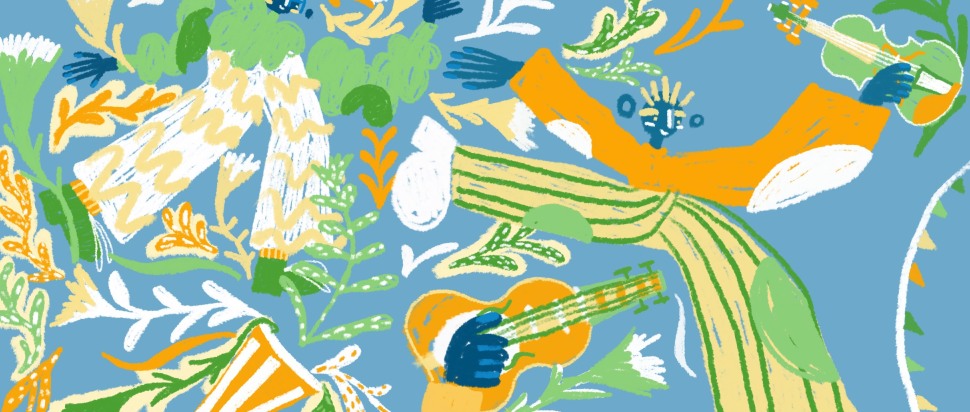Queer as Folk: Exploring LGBTQ+ stories through Scottish folk culture
Tradition is far from fixed. Composer Finn Anderson explores shared legacies, the connections between folk and queer culture, and the joy in celebrating both
As a young gay kid growing up in a small fishing village I found escape in the world of musical theatre. Theatre offered me a place to dream, to imagine different realities, and to embrace emotional expression in a world where boys are often encouraged to contain themselves. Scotland doesn’t have a history of 'musical theatre' as we think of it today. However, we do have a long history of ballads; stories told through song which are often highly dramatic. Maybe in a different time or a parallel world, this young queer Fifer would have turned to the ballads for escape instead.
In recent years, through my theatre and singer-songwriter work, I’ve been exploring the hidden histories of LGBTQ+ people; researching the traditional songs and stories of Scotland’s past and present; and embracing the sense of wonder I’ve felt since childhood for Scotland’s landscapes and bodies of water.
Celtic folklore often wrestles with our complex relationship to the natural world; whether that be through mythic characters who represent different seasons, or the elemental imagery and metaphor woven through many ballads. This legacy left by generations of storytellers and song-makers allows me to root myself more deeply in the landscapes around me. Equally, as a gay man today with more freedom than many who came before, unearthing stories of LGBTQ+ history helps me to find my place in a different kind of legacy, and to better understand the struggles that other members of the queer community are facing now in Scotland and beyond.
Maybe what I’m slowly discovering is that, for me, 'folk culture' and 'queer culture' overlap, not only because they form key parts of my identity and increasingly meet in my work, but because my queer friends and chosen family are my 'folk', and that community has, through necessity, created its own culture. And, if 'folk culture' is the culture of a distinct social group, preserved and passed down over time, then could the unique things that make up what we consider 'queer culture' be thought of as a kind of folk culture in its own right?
Traditional folksongs and folktales are hard to pin down. They were rarely put in writing but passed orally through generations, transforming with every new person and place they encountered. I like to think of queer culture as evolving in this way too. Even the word 'queer' itself has taken on new meaning in being reclaimed by the very community it was weaponised against.
To keep traditions alive, we have to make them relevant and useful for contemporary communities.The Scottish ballads teach us a lot about how our landscapes, beliefs, and social structures looked in the past. But they teach us very little about the lives of queer people, other than that they appear to be invisible for the most part. Today, queer artists creating in conversation with the traditional music and folklore of Scotland, means that future generations of LGBTQ+ people in Scotland will be able to see themselves reflected within that culture.
In 2018, I was lucky to be part of a project started by Pedro Cameron (aka Man of the Minch) which brought together LGBTQ+ folk musicians under the banner of Bogha-Frois (Gaelic for 'rainbow'). The project helped me rekindle my dormant relationship to Scottish traditional music, bringing me into community with queer musicians who were carrying and reframing that music in a way that I hadn’t imagined possible. This gave me a renewed sense of belonging in Scotland’s folk culture, which has carried through into the work I'm making now – a new folk musical A Mother’s Song, which harnesses traditional ballads to tell a contemporary queer narrative.
I’ve heard it said that tradition allows us to be in the past, the present and the future all at once. I love this idea. By doing the same thing at the same time each year (whether dancing the same dance, singing the same song, or sharing a meal with the same people) we can reflect on who we are now in relation to who we’ve been in the past, and imagine who we might become in the future.
This year I brought in the new year in a beach ceilidh, which my mum has called every year for twenty years. Due to her ill health, this year the dance calling fell to me and my brother. The event is always cross-generational. But for the first time this year, I brought some of my chosen family together with friends and family who have known me since I was born. I danced with my boyfriend to a tune played by the same fiddler who has accompanied this ceilidh every year since it began. As we danced and sang the same dances and songs as last year, I reflected on how much more congruous life feels for me these days, as I work on projects that combine my queer identity, my country’s folk music and folklore, my passion for musical theatre, and my wonder for Scotland’s natural landscapes.
Finn Anderson and Tania Azevedo’s major new folk musical A Mother’s Song opens at Macrobert Arts Centre, Stirling 23-26 Feb
